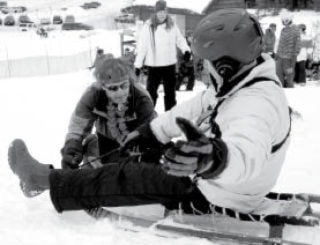Each year a group from Rossland’s Radical Luge Club fences off a piece of Red Mountain, builds a luge course, and spends a few days passing on their love of luge to anybody with the temerity to try and/or the drunkenness to dare.
“It’s not going to stop you on a dime, it’s just going to slow you down,” said Mike “Slo” Curry of the Slocan Valley as he explained how to put on the brakes to a new luger on Friday.
“He only thinks Slo,” joked fellow luger Dave Deno who was looking on, “he doesn’t go Slo.”
So, how does one luge?
“It’s a state of mind. It’s a constant state of luge,” Slo said, cracking a brew with a pensive look.
“It’s just tobogganing for adults, but kids do it too,” he continued. “It’s what we did growing up, sliding downhill on implements.”
“Luge gives you the opportunity to do it safely. You can brake it, you can turn it, and it gives you a track to ride on. It’s just one step up from toboggans, inner tubes, and crazy carpets.”
Luge was invented sometime in the 19th century in St. Moritz, Switzerland, and the first recorded competition was in 1883, also in Switzerland.
“I personally got involved in Alberta, in the late 1980s,” Slo said. “Then I moved to the valley and we heard there was a club here, so that’s what brought me here, sliding. I’ve been coming ever since.”
“We’re teaching the basics. How to stop. How to turn,” he said.
To stop, it’s “a combination of your feet braking and pulling up on the reins.” That’s the easy part.
To turn, “you’re using the rein and pushing on the kufens [runners].”
To turn right, for example, you pull up on the right rein (with the left hand), while pushing the left kufen with your left leg. Meanwhile, the right hand is spread out to the side to brush the ground and the right leg is also swung out to the side, to keep it clear of the right kufen.
To turn left, all the bits needs to swap sides quickly, perhaps with a swift brake in between to keep from flying too fast around the corner.
There was so much interest at Friday and Saturday’s learn to luge — some 50 people each day — that they had to turn people away.
“We’re overwhelmed,” Slo said. “This is what it’s all about, this carnival weekend. We want to turn people on to luging. We only have the track in for five days.”
Some 30 people competed in the race on Sunday. Those who raced their three runs and showed their ability to navigate the course safely and competently were allowed to join the Radicals’ club, the chief benefit being the official qualification to run down Rino’s after the hill closes.
“There’s not many sliders who are qualified to go to Rino’s run,” Mike said, “It’s not for everybody, it’s pretty extreme.”
On Sunday, as the sun shone on the hardpack course on which Danimal had just secured his first place finish, and the club members ate pizza and drank pitcher (after pitcher), some mentioned that it’s a shame the track isn’t in all season.
“You know,” Slo said, “in the big picture, we’re skiers and boarders. If it was a powder day, we’d be skiing.”
